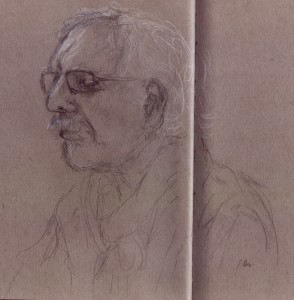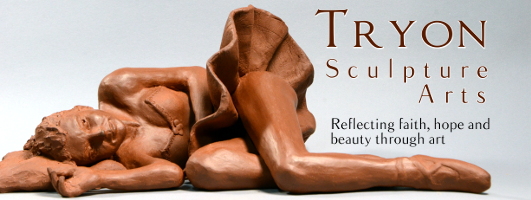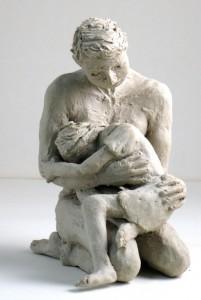 Over the past couple of months, I have been working my way through the process of transforming my sense of identity from the “computer geek who happens to be good at art” to, “the artists who still does some computer stuff.” I’ve actually been walking this journey for several years now, but things were suddenly accelerated when my IT and computer support job of seven years was suddenly pulled out from under me, bringing a 40 year career in the Computer Science and Software Development to a somewhat unceremonious end.
Over the past couple of months, I have been working my way through the process of transforming my sense of identity from the “computer geek who happens to be good at art” to, “the artists who still does some computer stuff.” I’ve actually been walking this journey for several years now, but things were suddenly accelerated when my IT and computer support job of seven years was suddenly pulled out from under me, bringing a 40 year career in the Computer Science and Software Development to a somewhat unceremonious end.
One of the first things which struck me in the middle of this process was the need to create a distinction between my role (what I do) and my identity (who I am). While my role may change, sometimes dramatically, that change should not fundamentally impact who I am.
As a Christ follower, I recognize that the absolute foundation for my identity is that of, “Child of God, created for fellowship with Him, and to fulfill His purposes in the world.” Unfortunately, this can become cliché, something that I’m expected to say, without any real meaning. Many people claim to be children of God, but there is little in their lives to say they have really thought about the implications.
The true power of identifying myself as “a Child of God” is that it forms the foundation for everything else which I claim to be. Like a well built foundation for a house, it may not be easily visible or flashy, but nothing else built on top would survive long without it. This foundation creates purpose, security, cohesiveness and direction for everything else as it is tested by the fires of life. Out of this identity flows other unshakables, such as Hope, Faith, Forgiveness, Grace and Truth. It reaches in and colors everything else, and as other building blocks come and go (or perhaps crumble over time), it is the one thing which remains.
Having established the foundation, there are many ways to build on it.
Even at the height of my IT career, I thought of myself as an artist. While my level of artistic output and skill have ebbed and flowed over the years, I always felt a deep sense of joy any time I could get my hands into my clay, or draw or spend time in creative writing. However, my identity as artist always took second place to my image of myself as the computer guy, the father, the husband, the provider, the teacher.
Now, suddenly, I find that my roles have been turned upside down. As I take a step back to look not only at the past couple of months, but the past several years, I can see that this shakeup has been a long time in the making. Just as an earthquake is created through the sudden release of many years of quietly building stress and movement, this sudden shift is simply the fruit of years of change and growth
In the middle of this shakeup, I am beginning to recognize another key component of my identity: the father.
The way we relate with our fathers is complicated and messy and often difficult to unravel. Yet, this relationship colors all other relationships around us and ultimately, how we see God as our heavenly Father. Unfortunately, for many of us, this relationship is either deeply flawed, or at least full of ambiguity and conflict. Even for those of us who understand our identity as a Child of God, our understanding of our fathers, and how we engage in that relationship, distorts how we see our heavenly Father, and how we believe He sees us as His children.
Our understanding of “father” is deeply ingrained in our emotions and our view of ourselves, and it is incredibly difficult to dislodge or reshape the painful, broken and distorted pictures we have in our heads and hearts. However, I have seen that it is not impossible to change. The role of father can be modeled for us, even when it was not done well by our physical fathers.
As I build relationships with people around me, I find that I often see those relationships through the lens of being a father. This expresses itself through caring, protection, encouragement, council, tenderness, listening, shepherding, laughing, speaking truth, and trying to reflect the things that our Heavenly Father is saying and feeling toward that person. I’ve had young people call me “father” on more than one occasion, and I have seen lives and attitudes slowly transformed as I have tried to simply express that role.
In reality, identity and roles intermingle, and our identity is built on top of many overlapping factors, but I believe it is fair to say that my life as an artist flows first from my relationship with God, and then out of my heart as a father to the countless “fatherless” people I interact with every day. My identity as a father quietly peeks out of my art, and in my passion to teach that art to others, especially children and young people. It flows in and out of the pieces I have created in response to the issue of human trafficking and justice. It shapes my expression as I reflect on the beauty our Father has created in the human form and the wonder of nature.
So, I am an artist now. I am still working through the implications of that change, but in the middle of the confusion and stress of re-shaping both my identity and my role, I find that I am filled with the overwhelming sense that, this is where I am supposed to be…

